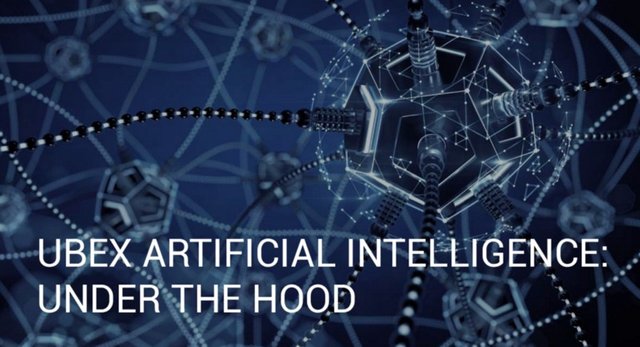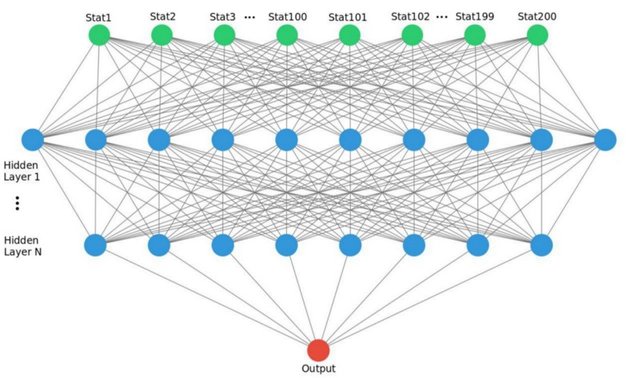UBEX Artificial intelligence: under the hood

Many people are interested in cutting-edge technologies and artificial intelligence based on neural networks is one of them. Some of us are scared of a future with artificial intelligence, others are craving such a future to come. However, no matter what we expect, this future is coming.
Nowadays, more and more projects are starting to use neural networks like UBEX whose goal is to deliver the only advertisement customers could be interested in. This goal cannot be accomplished without utilizing the power of artificial intelligence. But for most of us, these words are no more than marketing slogans buzzed from every advertisement. What does it actually mean to “use artificial intelligence” and how is it actually possible? Let’s find it out!
Neural networks are simple and complex at the same time. Simple, because they are just a simple mathematical equation, you simply have some input array of data and some output value or array of values as well. All you need to do is just solve an equation minimizing errors in the discrepancy between the calculated output and actual output. Simple, right? Solving such equations hundreds and thousands of times gives us a minimum error value, meaning that our calculated (predicted) result is very close to the actual result. But what is so complex you say. The complexity comes from building a data set, which can be used as a learning sample to get a good result with a good chance of prediction.
What does UBEX actually try to achieve? Deliver the advertisement to customers, but not simply show any popup with an ad, but show only the ad the customer could be interested in. If the level of interest is low, it is possible not to show an annoying advertisement at all. Isn’t it a good idea? It is a great idea! All of us are so tired of contextual advertisement, the future advertisement should be different! The main task, as we can see, is to measure the level of a customer’s interest to understand the possible set of interested advertisement materials.
The challenging part here is to gather enough customer data to predict their interests. It shouldn’t be personal customer data like names, exact age, exact location and so on. It should be statistical data showing the previous activity of a customer. The more data can be gathered, the more precise the result that can be obtained. Now imagine a neural network working for many years, it can hold a lot of statistical data and easily predict interests. But how can we get this neural network holding all this data if the project is just bootstrapped? It’s challenging, but UBEX has a solution here as well.
First of all, the main task is to get the customer’s interests. It doesn’t mean that UBEX has to teach the initial neural model by showing advertisement and predict customer interaction with an advertisement. The customer’s interests can be analyzed using any action or interaction based on his preferences. It can be, for example, a big internet shop with statistical data accumulated over many years. Or it can be a forum board or even social network where customer activity can be split by some map of interests. The model learnt by such customer interactions can be easily used to predict marketing interests as well. Of course it doesn’t mean that UBEX is going to use only non-marketing statistical data to show and predict the advertisement, but using this initial learnt model can be a good starting point for working with marketing statistical data at later stages.
Further evolution of the project assumes to encourage publishers to feed UBEX with customer marketing statistical data by installing the UBEX tracking code. As a reward for such activity, the publisher can gain some amount of UBEX tokens and this process can be considered mining. You simply get the UBEX tokens for providing customer statistical data. Good? Great!
Now let us see what does this statistical customer data look like? Remember that the input data of the neural network is an array of stats? Actually, it doesn’t matter what are that stats, more important is that these stats should affect the final result. As far as our final result is a list of customer’s interests, we should consider such stats that can be keys to user preferences. We are all human beings, and our preferences are constantly changing. Many factors can affect our interests and many stats can show our preferences as well. Age, for example, is one of those key stats, but not the exact age, the period of life. So we have the first stat “is the customer’s age between 0 and 16?” and value “1 or 0”. The second one “is the age between 16 and 25?” with the same values “1 or 0” and so on. Another bunch of stats can be based on location, but not the exact location again, the region. “Is the customer from Europe?” with value “1 or 0”, “is the customer from North America?” and so on. The next bunch of stats based on the customer’s activity. “Is the customer login less than 10 times for last month?”, “is the customer login from 10 to 30 times?”, “does the customer visit 10 pages or less during his visits?”, “does the customer visit from 10 to 30 pages during his visits?”, “does the customer spend less than 3 seconds on the page?”, “does the customer spend from 3 to 10 seconds on the page?”. The next bunch of stats can be addressed to particular interest categories. For example one of our categories is “laptops”, then “does the customer visit less than 5 pages in laptops category for the last month?” is a good stat, “does the customer visit from 5 to 10 pages in the laptops category for the last month?”, and so on. “Did the customer buy one good item from the laptops category for the last month?”, “does the customer buy from 1 to 3 goods from laptops category for last month?”, and so on. I hope everyone gets the idea. We should have an input array with hundreds of stats.

By having the input array of customer data, the neural network should try to predict the result. In our case, the result could be “does the customer have interest in laptops?”. The answer should be 1 for all cases where the customer bought at least one laptop for the last half of the year, for example. Or the answer can be 1 for all cases where the customer interacts with at least 20 laptops for the last 3 months (view pages with descriptions, view pictures, view articles about laptops, leave comments about laptops and so on). Having thousands of cases with such input data and results is enough to train the neural network.
After training, such a neural network can have only input with customer stats and calculate the output as a number from 0 to 1 for each considered category. So, basically, the neural network can predict the possibility of a customer’s interaction with a product in a particular category of interests. And these predictions will be closer to real observation the more accuracy the neural network will achieve. Continuous learning will lead to very good results and the UBEX neural core can easily predict customer interests and show only the advertisements customers are interested in. Or it doesn’t show an advertisement at all depending on the publisher’s preferences and the advertiser’s preferences.
I hope this article can be helpful for everyone interested in artificial intelligence and the UBEX project in particular. We appreciate your support.
By the way, the token sale is on for the last few weeks and you have a last chance to become part of the future and participate in the most dramatic changes in the advertisement industry.
For more info:
Website: https://www.ubex.com/
Whitepaper: https://www.ubex.com/wp/Ubex-Whitepaper-en.pdf?2182
Telegram: https://t.me/UbexAI
Author: Ubex: https://medium.com/@ubex
Reposted by: Cryptocraz
Bitcointalk Address: https://bitcointalk.org/index.php?action=profile;u=1698372